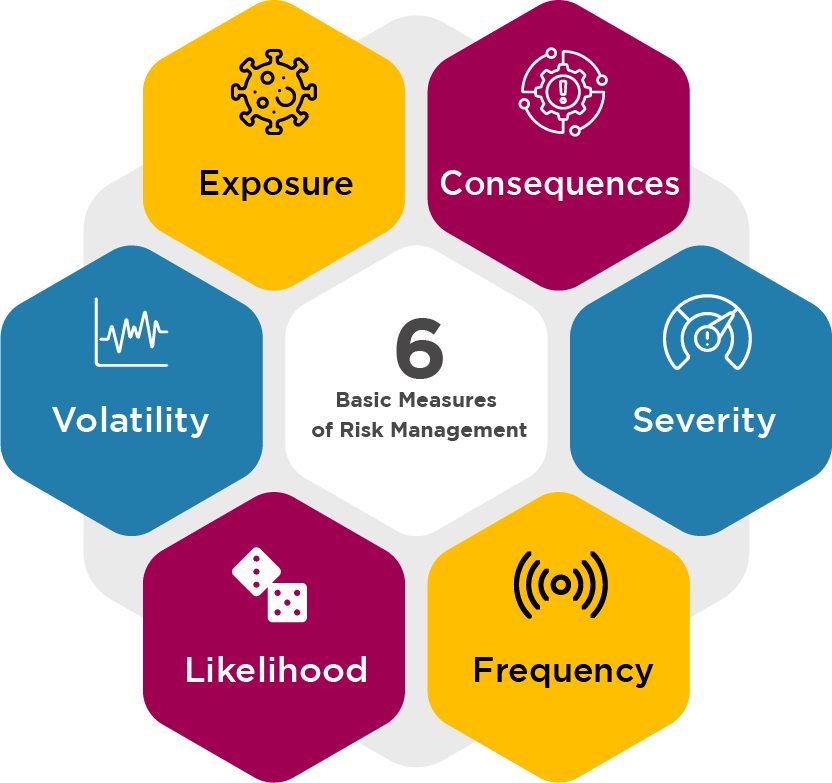1.4 Basic Risk Measures
Successful risk management involves identifying and analyzing risks. The identification and analysis of risks is collectively referred to as a risk assessment. For an organization to meet its objectives, it must be able to measure its risks so that it can take steps to improve them. Activities such as benchmarking risks by looking at a comparison of industry averages or risk scoring by calculating a number based on criteria to determine the level of risk are techniques commonly used by organizations to measure risk.
There are six basic measures that apply to risk management: exposure, volatility, likelihood, frequency and severity.

Exposure
This is a term that can mean many things depending on the context in which it is being used. In risk management it refers to the level of risk faced by an organization that exists even in the absence of an actual loss with respect to gains or losses. Exposure provides a measure of the potential damage associated with an occurrence. The level of risk increases as the exposure increases. For example, drivers who are on the road 12 hours per day increase their exposure to having an accident significantly more than drivers who are on the road only 1 hour per day. Most risks are quantifiable, but there are many risks that are not easily quantifiable. For example, the reputational risk of an organization might have to be measured by assessing sales after a negative event which affects the organization. Exposure to risk can be calculated using a simple formula:
Risk Exposure = Probability of the Loss × Amount in dollars of a Total Loss
Example
Volatility
This is a term applied to frequent fluctuations in the price of an asset. An increase in risk is directly proportional to an increase in volatility. The volatility of the stock market, commodity prices, and retail pricing can almost always be measured or quantified.
Likelihood
This is a key term that is used to measure the probability or frequency of an event occurring. The ability to calculate the likelihood of an event mathematically occurring is key to an insurance company’s success and to the ability to respond to risk by the risk management team in an organization. The likelihood of a risk occurring is addressed by loss prevention techniques. Loss prevention is a loss control technique that consists of measures that are taken before a loss occurs in an attempt to stop the loss from occurring. Employee training, reducing speed limits, and installing solid security locks on doors are all examples of loss prevention.
Consequences
This is a key term that is used to describe the impact or severity of an event that has occurred. The consequences involving the aftermath of an event that has occurred are addressed by loss reduction. The installation of an automatic sprinkler system, burglar alarms and emergency preparedness are examples of loss reduction. Loss reduction is comprised of pre-loss measures (before a loss occurs) and post-loss measures (after a loss occurs).
The Relationship Between Frequency And Severity
There is a relationship between the frequency and severity of losses, the responses by risk management and how they apply to hazard risks. The risk response to a hazard risk that is low frequency and high severity (fire) will be different than the risk response to a hazard risk that is low frequency and low severity (minor vandalism to a building).
- Time Horizon. Lengthy-time horizons pose more risk than shorter-time horizons because the potential for risk is in play for a longer period. It is sometimes difficult to manage the duration of time that an organization is exposed to a risk, but attempts to manage its uncertainty should be made as with any other risk.
- Correlation. If two or more risks are associated or similar, they are correlated. Highly correlated risks are subject to a high level of risk. A manufacturer’s supply chain would be highly correlated if it relies on key suppliers who are all located in a region that is subject to the same geopolitical risk.

